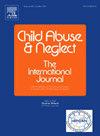儿童期虐待与青少年躯体、抑郁和焦虑症状:网络分析
IF 3.4
2区 心理学
Q1 FAMILY STUDIES
引用次数: 0
摘要
目的:本研究应用网络分析方法,在男性和女性青少年中确定躯体、抑郁和焦虑症状与儿童虐待之间的中枢和桥接节点。背景:青少年,特别是那些有童年虐待史的青少年,出现躯体、抑郁和焦虑症状的风险较高。然而,这些症状与虐待之间复杂的相互作用,以及性别的潜在影响,仍不清楚。采用多阶段整群抽样的方法,于2023年对10653名中国青少年进行了儿童虐待、心理健康和躯体症状的问卷调查。方法利用R Studio中的qgraph软件包进行网络分析,识别中心节点和桥接节点。结果网络结构和整体网络强度在性别上无显著差异。男性和女性都表现出共同的中枢结节——头痛、疲倦或精力不足以及情绪虐待——这些都是将童年虐待与躯体、抑郁和焦虑症状联系起来的核心。此外,情感虐待、情感忽视、睡眠障碍和睡眠困难被认为是共享的桥节点,是网络中至关重要的连接器。结论中枢节点如头痛、疲劳或低能、情绪虐待、桥梁节点如情绪虐待、情绪忽视、睡眠障碍、睡眠困难是关键因素。这些节点为公共卫生提供了有价值的见解,并代表了减少青少年身心健康负担的潜在干预目标。本文章由计算机程序翻译,如有差异,请以英文原文为准。
Childhood maltreatment and somatic, depressive and anxiety symptoms among adolescents: A network analysis
Objective
This study applied network analysis to identify central and bridging nodes linking somatic, depressive, and anxiety symptoms with childhood maltreatment among male and female adolescents.
Background
Adolescents, particularly those with a history of childhood maltreatment, are at an elevated risk for somatic, depressive, and anxiety symptoms. However, the complex interactions between these symptoms and maltreatment, as well as the potential influence of gender, remain unclear.
Participants and setting
A multi-stage cluster sampling strategy was employed to conduct a questionnaire-based survey on childhood maltreatment, mental health, and somatic symptoms among 10,653 Chinese adolescents in 2023.
Methods
Network analysis was conducted utilizing the qgraph package in R Studio to identify central nodes and bridge nodes.
Results
No significant gender-based differences were observed in the network structure or overall network strength. Both males and females exhibited common central nodes—headaches, tired or low energy and emotional abuse—that were central to connecting childhood maltreatment and somatic, depressive, and anxiety symptoms. Furthermore, emotional abuse, emotional neglect, sleep disturbance, and trouble sleeping were identified as shared bridge nodes, serving as crucial connectors in the networks.
Conclusions
Central nodes such as headaches, tired or low energy and emotional abuse, along with bridge nodes like emotional abuse, emotional neglect, sleep disturbance, and trouble sleeping, emerge as critical elements. These nodes provide valuable insights for public health and represent potential intervention targets to reduce the mental and physical health burden in adolescents.
求助全文
通过发布文献求助,成功后即可免费获取论文全文。
去求助
来源期刊

Child Abuse & Neglect
Multiple-
CiteScore
7.40
自引率
10.40%
发文量
397
期刊介绍:
Official Publication of the International Society for Prevention of Child Abuse and Neglect. Child Abuse & Neglect The International Journal, provides an international, multidisciplinary forum on all aspects of child abuse and neglect, with special emphasis on prevention and treatment; the scope extends further to all those aspects of life which either favor or hinder child development. While contributions will primarily be from the fields of psychology, psychiatry, social work, medicine, nursing, law enforcement, legislature, education, and anthropology, the Journal encourages the concerned lay individual and child-oriented advocate organizations to contribute.
 求助内容:
求助内容: 应助结果提醒方式:
应助结果提醒方式:


